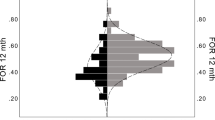Summary
Craniofacial morphology was studied in 45 shunt-treated hydrocephalic children and 7 untreated hydrocephalic patients. A sample of 74 normal children from northern Finland were used as controls. Following shunt treatment the sella turcica became shallow and J-shaped. The cranial base angles changed markedly during shunt treatment. The cranial base angles were more obtuse in untreated patients than in control subjects, whereas the opposite was the case in shunt treated patients. The Nasion-Sella-Basion angle was 143.4 degrees in untreated hydrocephalic patients, 132.6 degrees in normal subjects and 127.9 in shunt-treated hydrocephalics. The changes in cranial base angles appeared to be progressive during a two-year follow-up period.
Similar content being viewed by others
References
Adeloye A (1982) Acquired craniosynostosis following ventriculoperitoneal shunt for hydrocephalus. Monogr Neural Sci 8: 102–104
Andersson H (1966) Craniosynostosis as a complication after operation for hydrocephalus. Acta Paediatr Scand 55: 192–196
Anderson R, Kiefer SA, Wolfson JJ, Long D, Peterson HO (1987) Thickening of the skull in surgically treated hydrocephalus. Am J Roentgenol 110: 96–01
Huggare J, Kantomaa T, Rönning O, Serlo W (1986) Craniofacial morphology in shunt-treated hydrocephalic children. The Cleft Palate 23: 261–269
Guthckelch AN, Sclabassi RJ, Vries JK (1982) Change in visual evoked potentials at hydrocephalic children. Neurosurgery 11: 599–602
Ito H, Kawakami H, Maruyama H, Miwa T (1982) Clinicopathological consideration of late death in case of treated hydrocephalus. Neurol Med (Tokyo) 22: 51–58
Kantomaa T, Huggare J, Rönning O, Serlo W: Cranial base change in shunt-treated hydrocephalic children. Submitted for publication
Kaufman B, Sandström H, Young HF (1970) Alteration in size and configuration of the sella turcica as a result of prolonged cerebrospinal fluid shunting. Radiology 97: 537–542
Koski K (1953) Analysis of profile roentgenograms by means of a new “circle” method. Dent Rec 73: 704–713
McCullough DC, Fox JP (1974) Negative intracranial pressure hydrocephalus in adult with shunt and its relationship at subdural haematoma. J Neurosurg 40: 372–375
McPherson DL, Amlie R, Folz E (1985) Auditory brain stem response in infantile hydrocephalus. Child's Nerv Syst 1: 70–76
Schey WL (1973) Plain film skull roentgenographic change in hydrocephalus. Am J Roentgenol Rad Therapy Nuclear 118: 134–146
Serlo W (1985) Shunt treatment of hydrocephalus in children. Thesis. Acta Univ Oul D: 130
Author information
Authors and Affiliations
Rights and permissions
About this article
Cite this article
Huggare, J., Kantomaa, T., Serlo, W. et al. Craniofacial morphology in untreated and shunt-treated hydrocephalic children. Acta neurochir 97, 107–110 (1989). https://doi.org/10.1007/BF01772818
Issue Date:
DOI: https://doi.org/10.1007/BF01772818




